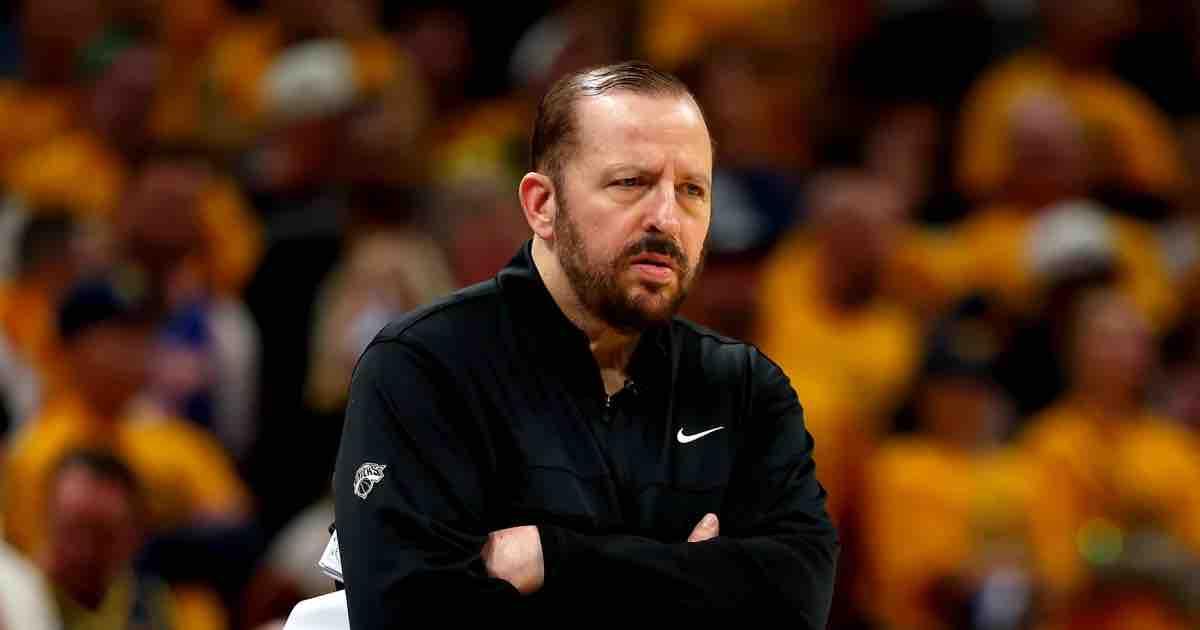After a 2–3 start and a blowout loss to Chicago, questions arise about the Knicks’ decision to fire Tom Thibodeau. Mike Brown’s up-tempo offense is clashing with a roster built for defense — and Karl-Anthony Towns is struggling to adapt.
The New York Knicks entered the 2025–26 NBA season with optimism following last year’s impressive run to the Eastern Conference Finals.
But just five games into the new campaign, their 2–3 start — capped by a 135–125 loss to the Chicago Bulls — has sparked serious debate about whether the offseason coaching change was really necessary.
As Steve Popper of Newsday observed, management may have tried to “fix something that wasn’t broken.”
From Thibodeau to Brown: A Radical Shift in Philosophy
After five years under Tom Thibodeau, who emphasized half-court execution and elite defense, the Knicks opted for a fresh voice in Mike Brown, known for his up-tempo, ball-movement-heavy approach.
The idea was to modernize the offense and involve more players, avoiding the heavy-minutes workload that became a hallmark of Thibodeau’s tenure.
Brown has delivered on that promise — deploying 10-plus players in each game and spreading minutes more evenly. Yet the shift has come at a cost: the Knicks’ once-feared defense has faltered, and the offense has yet to find rhythm.
Against Chicago, a team tailor-made for transition play, New York gave up 135 points and struggled to keep up.
A Roster Built for Thibodeau, Not Brown
Popper notes that New York’s roster is still largely constructed for Thibodeau’s slower, defensive identity.
Players like Josh Hart, Julius Randle, and Karl-Anthony Towns thrived in a physical, grind-it-out system. Under Brown’s faster pace, their roles have shifted — and not always comfortably.
Karl-Anthony Towns Faces the Toughest Adjustment
No one has felt the transition more than Karl-Anthony Towns.
After being used primarily as a center last season, Towns is now logging more minutes at power forward, where he’s expected to run the floor in transition and defend on the perimeter — responsibilities that don’t fully match his skill set.
According to Popper, the change has left Towns looking out of rhythm on both ends of the court.
He hasn’t directly criticized his new role, but after Friday’s loss, his frustration was evident:
“Obviously we’re not happy. We had three winnable games and didn’t do enough to close them out,” Towns said.
“Last year that was our identity — we closed games. It’s a different feeling not being able to finish.”
His words reflect a broader truth: this Knicks team is still searching for cohesion under its new direction.
Can Brown Reignite the Knicks’ Identity?
It’s still early, and growing pains are expected with any coaching transition. But New York’s struggles raise valid questions about whether Brown’s system suits this roster — or if Thibodeau’s defensive foundation was prematurely dismantled.
For now, the Knicks must find a balance between Brown’s offensive innovation and the defensive grit that made them contenders. If they can’t, their bid to remain among the East’s elite could unravel quickly.
Other news - New York Knicks
Other news
- 13:30 MLS Free Agency 2025: One Player Every Club Should Be Watching Closely
- 12:33 Knicks Eye Defensive Pest Jose Alvarado as Title Push Intensifies: A Perfect Deadline Fit?
- 10:13 The Engine Behind New York’s Rise: How Jalen Brunson Is Powering the Knicks Into Contention
- 09:08 New York City FC to Participate in 2026 Lamar Hunt U.S. Open Cup
- 08:06 New York City FC Forward Alonso Martínez Undergoes Knee Surgery
- 14:00 Knicks’ Breakout Guard in Jeopardy: Miles “Deuce” McBride’s Ankle Scare Sends Shock Through New York
- 12:20 CHAMPIONS! Inter Miami & Lionel Messi win MLS Cup over Vancouver Whitecaps
- 13:15 Jalen Brunson Shrugs Off MVP Talk After Torching the Bucks: ‘When You Win, Everyone Eats’
- 12:04 NYCFC Crashes Out: Miami’s Five-Goal Surge Ends Cup Dream Despite Haak’s Heroic Header
- 17:30 Towns Reveals Why Shamet Made His Life Easier After Brunson’s Injury
- 16:30 USA Beat Paraguay 2–1 in Intense Friendly, but a Wild Sideline Brawl Steals the Spotlight | VIDEO
- 08:53 Shorthanded Knicks Shock the Heat: Shamet Drops 36, Towns Dominates in Explosive NBA Cup Win
- 00:13 Sensational move: Lewandowski close to leaving Barcelona? AC Milan on the move, but New York City FC is calling.
- 23:20 MLS to align calendar with top leagues around the world
- 22:43 Will Jalen Brunson’s injury derail the New York Knicks’ campaign?
- 14:24 New York City FC Must Keep a ‘Blue Head’ as Playoff Intensity Peaks in Charlotte
- 07:45 Knicks Dominate Timberwolves as Brunson and Anunoby Shine in Statement Win at MSG
- 01:40 NYCFC Urged to Keep ‘Blue Heads’ in Playoff Decider Against Charlotte FC
- 00:01 NYCFC and Charlotte FC Set for High-Stakes Decider: Pressure Mounts Ahead of Friday’s Showdown
- 14:00 Knicks Regret Firing Thibodeau? Mike Brown’s Fast-Paced System Sparks Early Turmoil
- 13:00 Nashville SC Keep Playoff Dreams Alive with 2–1 Win Over Inter Miami — Game 3 Awaits
- 12:11 Heartbreak in the Bronx: NYCFC Fall to Charlotte FC in Dramatic Penalty Shootout
- 20:00 NYCFC Eyes First-Ever Road Win vs. Charlotte FC — and Gets a Big Break with Zaha Suspended
- 18:00 NYCFC’s Fate Rests on Alonso Martínez and Hannes Wolf — Can the Stars End Their Scoring Drought in the Playoffs?
- 16:00 Thiago Martins: NYCFC Captain Embraces Leadership Role Ahead of Playoffs
- 14:00 Matt Freese: NYCFC’s Breakout Star Earns MLS Goalkeeper of the Year Nomination — and Pascal Jansen Credits His ‘Growth Mindset’
- 12:00 Knicks Emerging as Top Contender for Giannis Antetokounmpo Amid Trade Buzz
- 11:00 Pascal Jansen on NYCFC’s ‘Bulletproof Mindset’: The Mental Edge Driving Their Playoff Push
- 10:00 Knicks Score Long-Term Win With Mikal Bridges’ “Discount” Contract Extension
- 09:00 The Jennifer Lopez Glow Arrives in Umbria: HydraFacial at Tenuta Fogliani Resort & Natural SPA
- 08:32 MLS: Seattle and Columbus lose in Game 1, but Minnesota and Cincinnati win early
- 23:01 NYCFC vs Charlotte FC: Pascal Jansen Missing Key Trio Ahead of Saturday Night Clash
- 15:49 Pascal Jansen Confident Ahead of Charlotte Clash: “We Were Dominant — Now It’s Time to Take Our Chances”
- 11:00 The Secret to a Relaxing Holiday in Umbria: Tenuta Fogliani Resort & Natural Spa
- 08:54 Pascal Jansen Rallies NYCFC: “The Moment Is Here” as Playoffs Begin Against Charlotte FC
- 23:27 New York City FC Set to Face Charlotte FC in Thrilling MLS Cup Playoffs Round One Best-of-3 Showdown
- 14:23 Heartbreak at Citi Field: NYCFC Fall 2-1 to Seattle Sounders After Late Drama on Decision Day
- 14:00 NYCFC Bids Emotional Farewell to David Lee After 11 Years: “One of MLS’s Most Respected Sporting Directors”
- 12:00 David Lee Bids Farewell to NYCFC: “This Team Has an Incredible Future Ahead”
- 08:00 Shock in MLS: David Lee Leaves NYCFC After a Decade to Join Sporting Kansas City
- 15:45 Messi Close to Signing New Contract with Inter Miami Until 2028
- 10:55 NYCFC Transfers Mounsef Bakrar to GNK Dinamo Zagreb
- 10:39 NYCFC Defeats Club León 2-0 in Leagues Cup Clash: Goals from Martínez and Ojeda, Freese Shines in Goal















